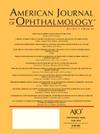The effects of Vitamin D on Keratoconus progression.
IF 4.1
1区 医学
Q1 OPHTHALMOLOGY
引用次数: 0
Abstract
PURPOSE The aim of this study was to assess whether Vitamin D (Vit D) supplementation affects local disease progression, as well as systemic inflammation, collagen degradation, and oxidative stress in adolescents affected by Keratoconus (KC) and Vit D deficiency. DESIGN Prospective, interventional single-center study. SUBJECTS Forty patients (age range, 12.2-19.9) presenting with both KC and Vit D insufficiency (<30 ng/mL) were included in the study. METHODS Vit D was prescribed for 6 months as per standard of care. Follow-up visits were scheduled for 12 months. Each visit included the measurement of best spectacle-corrected visual acuity (BSCVA) , maximal keratometry (Kmax) , and thinnest corneal thickness (TCT) . Blood samples were collected at month 0 (M0) and month 6 (M6) to measure Vit D levels and systemic biomarkers of inflammation, collagen degradation, and oxidative stress by ELISA or RT-PCR; full RNA sequencing was performed on 20 patients at M0 and M6. MAIN OUTCOME MEASURES The primary outcome of the study was the percentage of patients with a Kmax progression less than 1 diopter (D) throughout the entire study (i.e.: stable patients) . RESULTS 65% of patients remained stable (75% of eyes) after 12 months. Specifically, BSCVA, Kmax, and TCT rates remained stable during the 12-month observational period. ELISA performed on blood plasma showed that Vit D upregulated the expression of VDBP. QPCR performed on peripheral leukocytes showed an increase in the expression of VDR and CD14 with no changes in the principal enzymes involved in Vit D activation/deactivation. ELISA and qPCR showed the modulation of collagen degradation and collagen crosslinking. Subgroup analysis with RNA sequencing showed differential response to Vit D treatment. Responder patients showed downregulation in inflammatory and platelet activation pathways, and upregulation of proteoglycan metabolism/biosynthesis enrichment. CONCLUSIONS Our findings support the hypothesis that Vit D supplementation can affect KC progression in adolescent patients with Vit D insufficiency possibly through the modulation of systemic inflammation, inhibition of collagen degradation and promotion of proteoglycan synthesis. Our results strongly suggest that KC may be the ocular manifestation of a systemic disorder.维生素D对圆锥角膜进展的影响。
本研究的目的是评估补充维生素D (Vit D)是否会影响青少年圆锥角膜(KC)和维生素D缺乏症患者的局部疾病进展、全身炎症、胶原降解和氧化应激。前瞻性、介入性单中心研究。研究对象40例同时存在KC和Vit D不足(<30 ng/mL)的患者(年龄范围,12.2-19.9岁)被纳入研究。方法按标准护理方法给予svit D治疗6个月。随访时间为12个月。每次访问包括测量最佳眼镜矫正视力(BSCVA),最大角膜测量(Kmax)和最薄角膜厚度(TCT)。在第0个月(M0)和第6个月(M6)采集血液样本,通过ELISA或RT-PCR检测Vit D水平和炎症、胶原降解和氧化应激的全身生物标志物;20例患者在M0和M6时进行全RNA测序。主要结局指标研究的主要结局是整个研究中Kmax进展小于1屈光度(D)的患者的百分比(即:稳定的患者)。结果65%的患者(75%的眼睛)在12个月后保持稳定。具体而言,BSCVA、Kmax和TCT率在12个月的观察期内保持稳定。ELISA检测血浆显示Vit D上调VDBP的表达。外周白细胞的QPCR显示VDR和CD14的表达增加,而参与Vit D激活/失活的主要酶没有变化。酶联免疫吸附试验和定量pcr结果显示,该蛋白对胶原降解和胶原交联具有调节作用。RNA测序亚组分析显示对Vit D治疗的差异反应。有反应的患者表现出炎症和血小板激活途径下调,蛋白聚糖代谢/生物合成富集上调。结论我们的研究结果支持了维生素D补充可能通过调节全身炎症、抑制胶原降解和促进蛋白多糖合成来影响青少年维生素D不足患者KC进展的假设。我们的结果强烈提示KC可能是一种全身性疾病的眼部表现。
本文章由计算机程序翻译,如有差异,请以英文原文为准。
求助全文
约1分钟内获得全文
求助全文
来源期刊
CiteScore
9.20
自引率
7.10%
发文量
406
审稿时长
36 days
期刊介绍:
The American Journal of Ophthalmology is a peer-reviewed, scientific publication that welcomes the submission of original, previously unpublished manuscripts directed to ophthalmologists and visual science specialists describing clinical investigations, clinical observations, and clinically relevant laboratory investigations. Published monthly since 1884, the full text of the American Journal of Ophthalmology and supplementary material are also presented online at www.AJO.com and on ScienceDirect.
The American Journal of Ophthalmology publishes Full-Length Articles, Perspectives, Editorials, Correspondences, Books Reports and Announcements. Brief Reports and Case Reports are no longer published. We recommend submitting Brief Reports and Case Reports to our companion publication, the American Journal of Ophthalmology Case Reports.
Manuscripts are accepted with the understanding that they have not been and will not be published elsewhere substantially in any format, and that there are no ethical problems with the content or data collection. Authors may be requested to produce the data upon which the manuscript is based and to answer expeditiously any questions about the manuscript or its authors.

 求助内容:
求助内容: 应助结果提醒方式:
应助结果提醒方式:


